

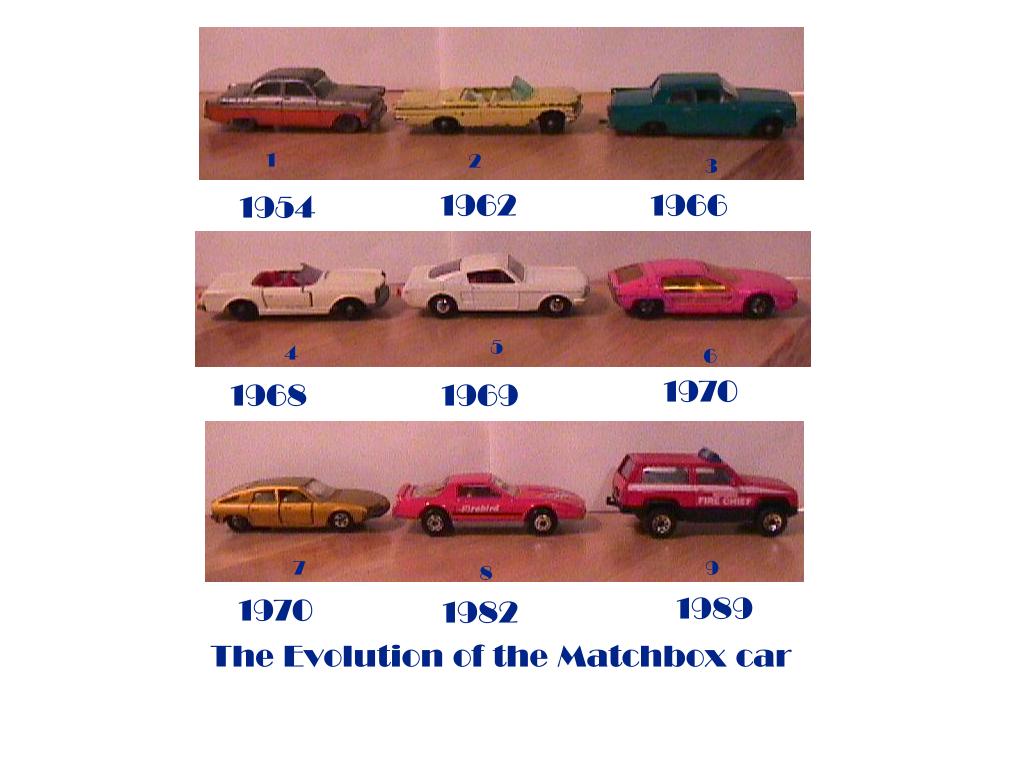



I have been collecting, playing with, customizing and yes, destroying 1-6x for as long as I can remember. I have always loved them, and they were and still are among my favourite toys. I have memories of Matchbox cars that go back to when I was two or three years old. I was too young to have them myself just yet, but my brother and sister had theirs, and I remember them playing with them. When I was old enough I got some of my own. Alas, very few of those original ones survived. Most of the ones I had from when I was a kid are actually replacements for ones that had gotten totaled; some of them were the second or third replacement.
I loved to play with them in the dirt and to create scenes around them. (Well, some things just never change; I'm still doing it today, 35 years later.) At one point I wanted to create a junkyard, so many of my older cars got bashed with a hammer to create the junk cars required for the junkyard. I set the scene up in a shelf in my room, and I thought it was awesome. Unfortunately, one day while I was at school my mom came into the room to clean and, not recognizing my super cool scale junkyard for what it was, she threw away all the cars thinking they were just a pile of broken stuff. AUGHH!
Part of the reason I started to hate school was that I spent all day worried about what mom was doing to my room at home while I wasn't there to keep an eye on her. If it were up to me, parents of kids who are in school would be under the supervision of "Parent Sitters," who watch them while the kids are at school to make sure they aren't in the kid's bedroom throwing away treasures that could be the kid's future down payment on his house OW . . . but I digress.
Today, my collection of 1-6x (which consists of mainly Matchbox with some Johnny Lightning, Corgi and Maisto thrown in) totals around 200 cars. I have examples of every level in the evolution of the Matchbox car (shown above) going all the way back to the beginning of Matchbox in the late 50's. The collection serves a double purpose: They provide the transportation for my HO scale village, and building the collection is a hobby itself, including restoration and customizing of 1-6x vehicles. I have other sections dedicated to both the HO village and the customization of 1-6x elsewhere on this web site. This article is about the history of Matchbox and the particulars of collecting 1-6x.
BEFORE THERE WAS MATCHBOX, THERE WAS LESNEY CORP.....
I don't want to go into the entire history of Matchbox, so here is a very quick rundown. Refer to the chart at the top of the page to understand the evolution.
It starts with two guys who had the same last name but weren't related: Leslie and Rodney Smith, who knew each other from school. They entered into a partnership and founded "Lesney Products" in Great Britain in 1947. The Lesney Company went into business making metal parts for industry. In a 1949 attempt at diversification, the partners used their industrial die casting equipment to make some small metal toys to sell in area stores. By 1952, Lesney had a contract to sell its toys in Woolworth Stores. In spite of this, the toys weren't very big in England; the toy merchants didn't think much of them. The Lesney Company was, however, determined to market them and went around the doubtful merchants to the children directly. The children loved the toys, and the demand for them soon convinced the merchants to stock them.
In 1953, Lesney realized that the demand for the new toys was going to rapidly outstrip their ability to meet it. Rather than shoulder the huge investment that would have been required to meet the demand, the Lesney Corp. went in search of a partner and soon found one.
IS IT LESNEY OR MOKO?
The man they decided to take on as their partner in the
new toy business was Moses Kohnstam of Germany. He was an expert in distributing
products and providing financial backing for promising new business ventures.
He made his profit from taking a percentage of the price of the things
he sold. He had his own company which was named after himself, "Moko."
He had a policy that all products that he sold had to carry his company
name. So, Lesney toys sold outside of Great Britain bore the name Moko-Lesney.
(See Pic 1)
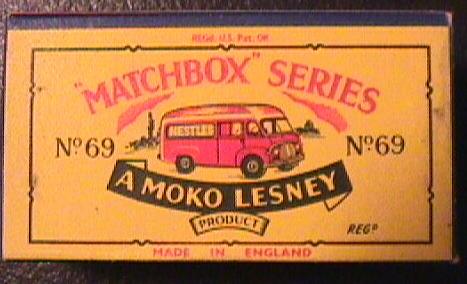
PIC 1 An Early Moko-Lesney box.
Later in that same year, Lesney made the single biggest and most important decision in their history; they decided to create and market an entire line of quality miniature cars based on real cars. They would be painted in nice colours and have the best detail possible. This was the beginning of the 1-75 Car series that every child and Matchbox enthusiast knows so well.
The following year, Lesney produced 18 models and and created the famous trademark name "Matchbox," which was also half owned by Moko. 1954 also marked the first time Matchbox cars were exported to the U.S.
In 1958, Lesney bought out Moko's half stake in
the Lesney-Moko product line. One year later, Lesney produced its first
catalog of Matchbox toys.
In 1964, Lesney Products formed Lesney Products USA.
Continuing to grow,
Lesney Products Corporation was formed in 1970.
However, in 1982 Lesney Products Corporation went into receivership, and
later that year, Lesney Products Corporation ceased existence.
The Matchbox Toy Division was spun off as a new company, then sold to a Hong Kong company by the name of Universal International. Finally, in the late 80's Mattel purchased Matchbox and merged it with its incredibly successful Hot Wheels line.
The chart at the top of the page shows the changes made by Lesney over the years. The first car on the chart (1) is an example of the "Moko-Lesney" years. You can recognize them by the small gray wheels. The next one (2) represents the Matchbox made by Lesney Corp. in the Early Sixties. It's still small but has a thicker axle and larger black plastic wheels.
(3) The fully evolved "Plain Wheel" Matchbox car. The body is larger and by now ALL the cars had plastic interiors.
(4) The 1968 - 1969 series was the end for the plain wheel models.
(5) For a short period of time, a small number of Matchboxes were available with metal hubs and with real rubber tires over them. An example of this can be seen in the 1969 model Mustang shown in the diagram.
Shortly after that, Matchbox came out with a whole new series of cars (and reissued some of its older models.) The new series had an entirely new wheel, axle and suspension system. The new system was designed to compete with Mattel's Hot Wheels. The new designs were called Superfasts.
(6) An example of an early Superfast model.
(7) Another feature of the Superfasts was Metallic paint. This was also in answer to Mattel's Hot Wheels.
(8) This is an example of a Matchbox manufactured by Universal International. UI's philosophy was to focus on making more American cars and cars that American children would recognize. That was a smart philosophy; it's just too bad that Lesney didn't implement it while they still owned the company. If they had, Lesney might not have gone bankrupt.
(9) This is a Mattel-Matchbox manufactured in China. It has much more plastic than the old Lesney Matchboxes do. But it also holds up better over time. This one has actually been played with extensively by a kid who got it when he was seven years old. You would never know it to look at it. It looks mint. This is because Mattel has improved it's manufacturing so much. Compare it to the 1962 model (2) which is in "played with" condition to see the difference.
SO WHAT SCALE IS A MATCHBOX?
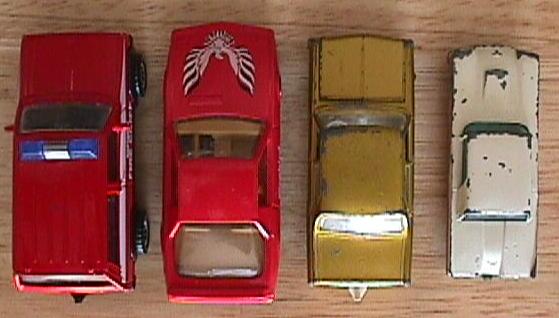
Well, the answer to that question depends on a number of things.
1. How old is the Matchbox? As you can see from
the pic above, the old '58 Thunderbird on the right is smaller than the
'82 Firebird (second from left.)
The old "Moko" Thunderbird is a much smaller scale than
the Universal (Matchbox) Firebird. At the same time, you can see that the
Firebird is actually a little longer than the the Mattel-Matchbox Jeep
Cherokee on the far left. It's obvious that Matchbox is more interested
in keeping their models to within a certain size of each other than they
are in keeping the models perfectly scaled.
2. Which Matchbox is it? Is it a car or a truck or a bus? These are important points too. In the pic above the Firebird is bigger than the Jeep. That would not be the case in real life. Therefore the two models are not scaled to each other. Universal and Mattel Matchbox have been nice enough to put the scale on the bottom of both models. The Jeep is 1/58 while the Firebird is 1/62. Obviously the Jeep is made to a larger scale. Larger vehicles such as the Greyhound bus are scaled down ever further to keep the size consistent with other Matchbox vehicles. The result of this is that it's almost impossible to use the larger vehicles in a scene.
COLLECTING 1-6x DIE CAST
If you are like a lot of people I know, you have your own fond memories of collecting and playing with 1-6x die cast cars when you were a kid. If you still have that connection to your childhood, as many adults do, you probably still have all or part of that collection.
Now, perhaps you are thinking you would like to retain a little of that childhood joy by becoming a serious collector of these fun and interesting toys. Well, I sure can identify with those feelings, and hopefully I can give you some useful information to help you on your way.
COLLECTING FOR FUN OR PROFIT?
Let me help set a few things straight right out of the gate. If you are going to start becoming a serious collector of die cast you should be doing it because you like it and it brings you pleasure. You shouldn't worry about "What are they worth?" and "Can you make a profit?" The answer to that first one for most die cast is "Not much." and the second "Probably not." Now that I have put those cards truthfully on the table, I'm going to pause while the people who were getting $$$ in their eyes leave the room.
Ok, now those of you who are still here are here because you are interested in collecting die cast for the fun of it. You are the folks to whom this site is dedicated. Now let me let you in on a little something. It's true that most 1-6x die cast isn't worth much, but some pieces are worth a lot of money! If you have the right pieces and they are in the best possible condition.
Well then, which ones are worth a lot? To answer that question I invite you to go back to your own childhood die cast experience. Your experience as a kid with 1-6x differs with how old you are of course. Even so, it should be fairly consistent. Start with this: Which models did you have when you were a kid? Which ones did your friends have? Now, out of all of those, the ones you had and the ones your friends had . . . which ones didn't you all have? In other words what models did only a few of you and your friends have? What models did none of you have? Answer those questions and you will be on your way to understanding which ones are valuable. That's right, the most valuable ones are the ones you didn't have.
Next Question: Why didn't you and your friends have them? There are two answers: 1) They were limited run, limited distribution, experimental models put out in only a few places to test interest. 2) They were immediately bought up by adult collectors who were expecting their release, and bought them all and put them away before parents could get any for their kids.
I have personal experience with (2) because I am an adult collector myself. It's not unusual for me to be down at Toys 'R' Us on a given day seeking out new and interesting models as soon as they are put out. If I do find one that I think will have future potential I might buy every single one they have and put them away, never opening the packages. The result is that by the time a parent or a kid gets there to buy some cars, there will be nothing but the common ordinary ones left. As I have more money to spend on die cast cars, plus a willingness to spend a lot more than a parent would for a kid, I am much more likely to be in possession of a valuable model in mint condition. This is nothing new; this was going on when we were kids too. I have no doubt in my mind that it didn't take long for adults to see the collectible value of the new die cast miniature cars when they first became available in the late 40's - to early 50's. Being adults, they had the ability to begin to grab up and put away the cars and keep them in mint condition. In thinking back to my own childhood experience, I can remember every model that I got as gift from the adults in my family or that I picked out at the store for myself. I can remember the selection of models that were available at the time; the models that were still in the store were the common ones. Occasionally there would be an unusual one but not very often.
SO WHICH ONES ARE THE MOST VALUABLE THEN?
To answer this question, you first have to consider a number of factors. First, "How old is it?" Next, "What condition is it in?" Finally, the big one: "How rare is it?"
To help you to better understand these factors, I am going to take you through a tour of my 1-6x die cast collection.
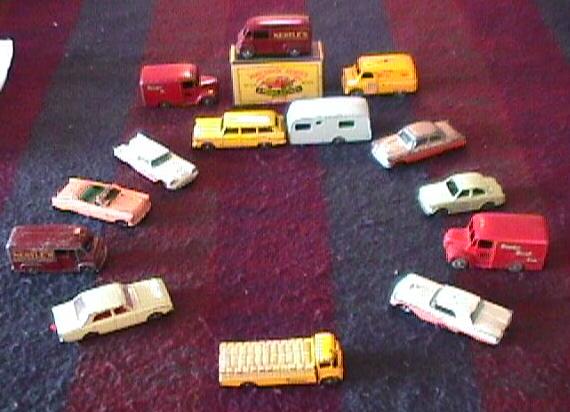
The first stop on the tour is my collection of the oldest models. Most of these date back to the 50's and are pretty rare. These are my "Moko" model Matchboxes and, as you can see, they are pretty small. They are the only Matchboxes to have the distinctive small gray wheels.
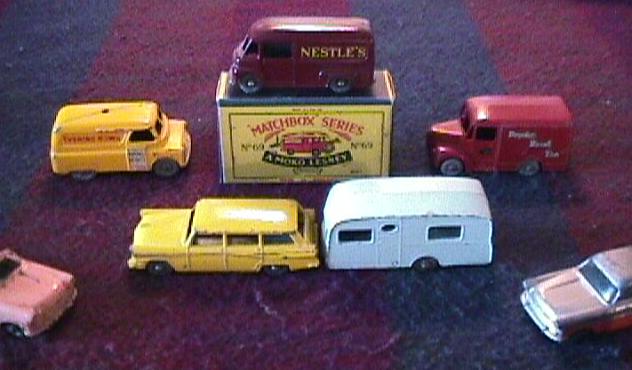
This grouping of Mokos is the center of my whole collection.
They are, far and away, the most valuable models that I have. Now, for
a little quiz to help you learn about the value of die cast. Take a look
at the pic above. Just by looking, which one do you think is the most valuable?
Which one is the least valuable?
Why do you think this is so? When you've made your picks,
scroll down to see the answers.
 Answers:
Answers:
Did you say that the most valuable one is the Nestle's
van with the original box? If you did, you are . . .wrong. You were close
though; that's the second most valuable. The most valuable one is the yellow
Ford station wagon. I paid $100.00 for it, and that was a bargain.
The Nestle's van with the box is worth around $80.00.
The Brooke Bond tea van (the red van on the right) is third at around $50.00.
The Ford Zodiac convertible on the left is the least valuable (about $10.00.)
All of this demonstrates why you need a good working knowledge of the product before you are ready to be a serious collector.
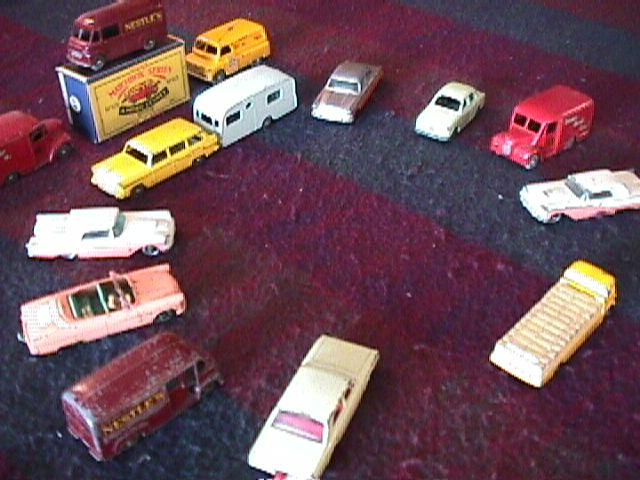

The pic above shows my collection of "transition models." Those are models that were manufactured after Lesney bought out Moko for Moko's holdings in the Matchbox operation. As you can see, these are the same bodies as the Moko models, but they have the more common plain black wheels. I included both versions of the Ford Corsair in the very front so you can see the difference. These models are not my best ones, as you can see by the condition, but they are worth more than you might think.
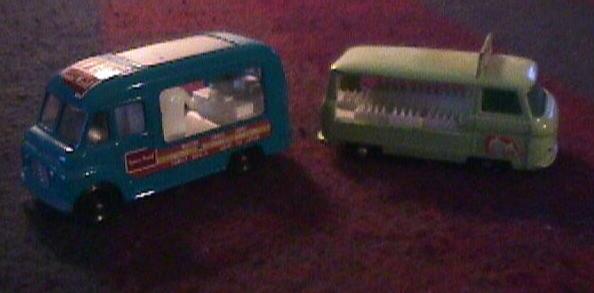
These two are the best ones in the transition collection. They are the #47 Commercial Ice Cream Truck and the #21 Milk Delivery Truck; again, they are called transition models because there are gray wheeled versions of them also. The interesting thing about this first transition is that the change went both ways. Some of the older smaller gray wheeled models were continued with black wheels, like the Ford Corsair shown in the group picture above. At the same time, some of the bigger, newer models were given the small gray wheels for a short period of time before being converted to the black wheels (like the Ice Cream Truck shown above.)
A DIME A DOZEN

I'll bet when you saw the pic above you said to yourself, "I had most or all of those when I was kid. In fact, I may still have them. Well, before you go racing up to the attic in search of them let me fill you in right now. These are worthless.
There are some plain wheel model Matchbox cars that are
so common that sometimes a collector will end up with three or four of
them without even trying. Even though they are Lesney models made in England
in the 1960's (which makes them over thirty years old) they are still commonplace.
Some of the best examples of these "dime a dozen" models are shown above,
in the condition that you are most likely to find them. The models in the
pic are: (from left to right)
Back Row: Tippax Refuse Truck #15, MG 1100 Hatchback
#65, Chevy Impala Taxi #20, Opel Diplomat #36, Refrigerator Truck #44 (usually
missing the rear door as this one is), Site Hut Truck #60 (the site hut
is usually long gone), Ford Cortina (may have a roof rack), Fire Pumper
Truck (the blue light on top is usually pushed down into cab, and maybe
the ladder and hoses on side torn off), Grit Spreader Truck.
Front Row: Land Rover Safari in Blue (may be missing
luggage from the top), mint green Lincoln Continental, Ford (yuck) Corsair
(Note: this is considered to be the least desirable Matchbox. People hate
it because: A) The color, B) It's out of scale to other black wheel matchboxes
of the period, C) It's ugly, D) It's usually always missing the green plastic
roof rack and boat that comes with it, E) They are so common it's ridiculous.
No one can explain why Matchbox made so many of these but they did.)
Continuing with the rest of the Front Row:
The Mercury Commuter station wagon it has two things
going for it. It was one of Matchbox's "Tilt and Steer" models. Its construction
was such that if you tilted the body it would steer the front wheels to
the right or left. The other thing going for it was that it was one of
the "silver hub" models which are much sought after. Every collector of
Matchboxes wants to have the complete set of "silver hubs," and that includes
the Mercury Commuter. So, if a person doesn't have one of these in his
collection yet, he would most likely pay to get one. So, it has a better
chance of selling than an ordinary black wheel model.
The Mercedes 300SE #46 in blue. This model was available
in both blue and green. Green is the rarer colour; blue is very common.
The Ford Galaxie Police car, usually with some or all
of the decals missing. It also tends to have the light removed, and suffered
someone's attempt to convert it from an police car into an ordinary sedan.
The Fire Chief's car suffers from the same problem. I
believe this is because Matchbox was so short of ordinary American models
that kids felt they needed to make their own.
The Silver Non-Pop-Up version of the VW Camper #34-D1,
usually missing one or both of the doors on the side. They were poorly
made, and it didn't take much to knock them off.
Finally, the Fiat 1500 #56 without the luggage on top.
These models are so close to worthless that the entire lot shown above wouldn't net $5.00 on eBay. For these to be valuable, they would have to be in mint condition; even then, they might have to have a box with them in very good condition.
There are more valuable versions of these, however, that are worth acquiring and holding. For example, the Refrigerator Truck would be worth quite a bit if the plastic door was intact. The Site Hut Truck should have the Site Hut. The Ford Cortina with the roof rack is very rare, and worth quite a bit but watch out -- the roof rack can be easily faked. The Fire Pumper would have to be in perfectly flawless condition with the light on top and the ladder and hoses intact. The plastic would have to be firmly attached, not loose in front, and it should be the model with the "Denver" decals on both sides. The Land Rover in green is rare and valuable; good luck finding one.
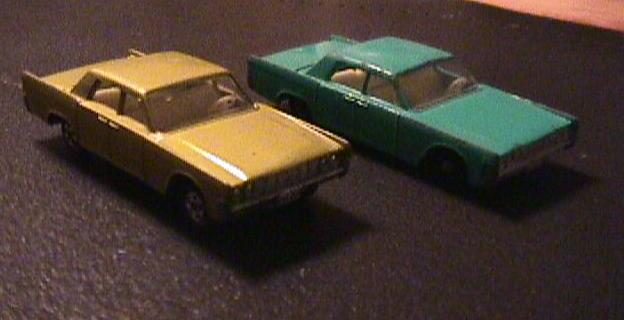
Here is an example of a common model along with its more valuable version. The Lincoln Continental #31 in mint green (on the right) is not worth much. In fact, in less than excellent condition it's hardly worth anything. There are, however two other versions of it; the original metallic blue plain wheel version (worth about twice as much as the mint green one), and the metallic green Superfast edition shown above left. This one is considered to be rare and is worth five times the value of the mint green model. Notice that the body is exactly the same on both models. Only the colour, wheels and suspension are different; this is another example of a transition model.
Other valuable versions are: The Moko or gray wheeled version of the Ford Corsair, especially if the green roof rack and boat are intact; The Mercedes 300SE in green; the VW Camper in green, with both of the doors intact; and the Fiat 1500 with luggage intact and, better yet, in red.
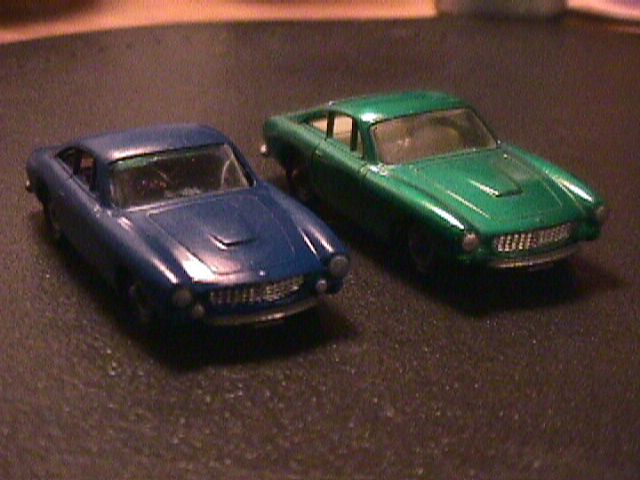
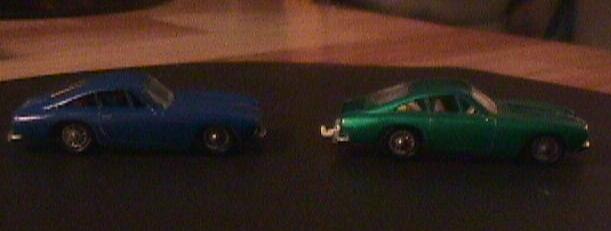
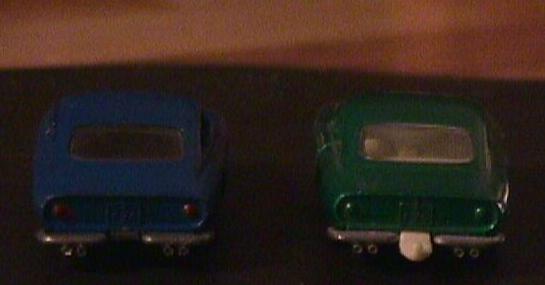
The above pix are another example of a common model with a less common version. This is the Ferrari Berlinetta #75. The green one on the right is pretty common, but it's one of the more valuable common models. It has the distinction of being the only Matchbox with wire spoke wheels (see second pic). There is also a silver hub version of it that's very rare, but the truly valuable one to be on the lookout for is the silver hub version in red! The blue one with the brown glove leather interior (above) is really just the common green one. This is from my custom shop; I just thought I would put this pic here to show you a different look for this car.
THE SILVER HUBS

Another transition period for Matchbox was marked with the appearance of several models with large silver hubs and separate plastic tires. Most likely, this was an attempt to try to create a "faster" wheel and suspension system to compete with Hot Wheels and Johnny Lightning. There were only a limited number of these models, some of which had the tilt and steer like the Mercury Commuter. The cars in the pic (from left to right) are: The Rolls Royce Silver Shadow #24 (mine is missing its trunk lid); The Ford Mustang #8 (the only Matchbox with the steering lever on the side; this model also has a rare valuable version and, once again, it's red. This one is worth $280 - $300; good luck finding one.) The last two are the Lamborghini Miura #33, and the Mercury Commuter. Not Shown - silver hubs that I don't yet have: The dark blue ISO Griffo, the Volkswagen 1500 (Beetle), the Mercury Police Car #55, and the somewhat rare dark green Ferrari Berlinetta sliver-hub and, of course, the super-valuable red Ferrari Berlinetta silver-hub, and the Volkswagen 1600 Fastback.
MULTIPLYING LIKE ROACHES: THE HATED FORD CORSAIRS
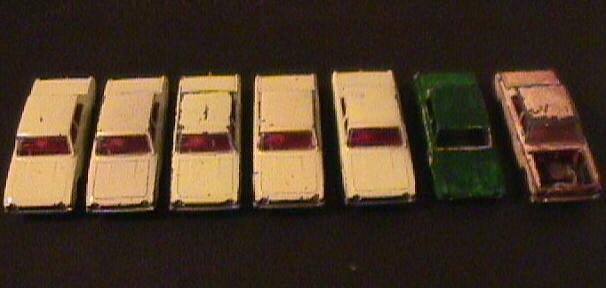
Ah, the things we collectors have to endure. I didn't set out to have seven Ford Corsairs; it's just that since everyone wants to get rid of this car, they throw it in with other cars in a lot. To buy the lot you have to take the Corsairs and, as you can see, they pile up. I only consider two of these to be part of the collection; they are the first two on the left. The second one is the Moko version; notice it's a different shade from the others. The two on the right are from the custom shop. This is customization for a different purpose. These two are used in my Junkyard scene (see my HO VIllage - coming soon.) They have been customized to fit the scene; notice that one of them is missing its hood. This is a neat trick, considering that the hood on the Corsair doesn't open. The three in the middle are doomed; most likely destined to be stripped for parts or maybe customized.
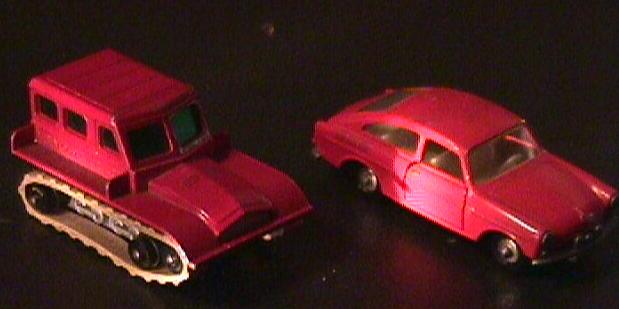
A couple of the more sought after models: The Volkswagen 1600 (Silver-Hub) and the Snow Cat with the tracks intact.
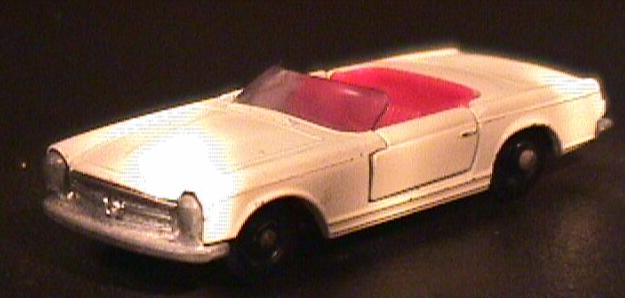
One of my most favourite plain wheel models, the Mercedes 230SL convertible (in excellent condition.) It's rare to find one like this with the windshield intact. Usually, it's broken off; I'm not sure why. I suspect that it's because they get stepped on. I currently have four of them in the collection. They are my favourite model to customize, so I try to acquire all of these that I can. This is another sought after, though common, model. If it's in excellent condition with the windshield intact, it's worth between $10 and $20. Even with the windshield gone, it might be worth $8; trashed out, it's still worth $2. I currently have two of these undergoing customization. I have a whole section on customization elsewhere on this web site.
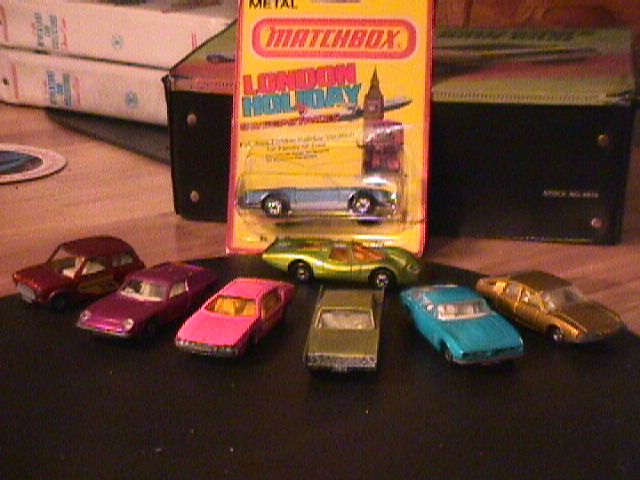
My entire collection of Superfasts. I don't have very many of these; largely because I have been busy filling in the Moko and "plain wheel" parts of my collection, and partly because there aren't that many Superfast models I really care for. Even so, I plan to be acquiring more as time goes on.
This is all of the collection that I'm going to be sharing at this time. I don't want this site to be just about my collection, my cars and my experiences. I want to hear from you about your 1-6x cars, your experiences and memories, and I want you to send me pix that I can feature on my website. So, please be sure to do that. You can email me at [email protected], or you can click this link. Webmaster
In the months to come, I will be sharing more of my experiences and talking about the rest of my 1-6x collection. The next big topic will be my Johnny Lightnings (which are now my second largest group after Matchbox) as well as my Maistos, Tomys and Tomikas.
So be sure to check back in and drop me a line.
![]()
 © 2000
© 2000